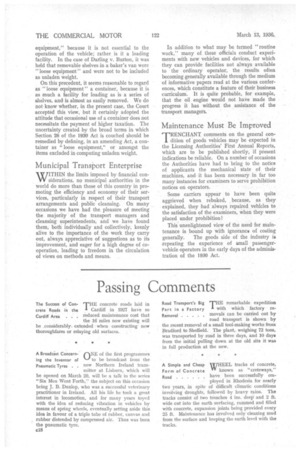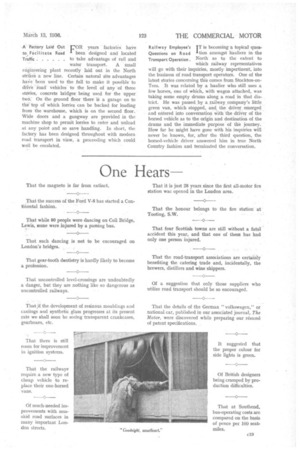Passing Comments
Page 70

Page 71

If you've noticed an error in this article please click here to report it so we can fix it.
The Success of ConTHE concrete roads laid in crete Roads in the I Cardiff in 1927 have so Cardiff Area reduced maintenance cost that the 16 miles now existing will be _considerably. extended when constructing new thoroughfares or relaying old surfaces.
A Broadcast ConcernON of thefirst programmes
Mg the Inventor of to be broadcast from the Pneumatic Tyres . . new Northern Ireland trans
mitter at Lisburn, which will be opened on March 20, will be a talk in the series "Six Men Went Forth," the subject on this occasion being J. B. Dunlop, who was a successful veterinary practitioner in Ireland. All his life he took a great interest in locomotion, and for many years toyed with the idea of reducing vibration in vehicles by means of spring wheels, eventually setting aside this idea in favour of a triple tube of rubber, canvas and rubber distended by compressed air. Thus was born the pneumatic tyre. Road Trans ports Big THE remarkable expedition Part in a Factory with which factory re Removal movals can be carried out by
road transport is shown by the recent removal of a srnall tool-making works from Bradford to Sheffield. The plant, weighing 72 tons, was transported by road in three days, and 10 days from the initial pulling down at the old site it was in full production at the new.
A Simple and Cheap WHEEL tracks of concrete. Form of Concrete VT known as "creteways,"
Road have been successfully em ployed in Rhodesia for nearly two years, in spite of difficult climatic conditions involving droughts, followed by heavy rains. The tracks consist of two trenches 4 ins, deep and 2 wide cut into the earth surfacing, rammed and filled with concrete, expansion joints being provided every 25 ft. Maintenance has involved only cleaning mud from the surface and keeping the earth level with the tracks. • A Factory Laid Out OR years factories have to Facilitate Road been designed and located Traftk to take advantage of rail and water transport. A small engineering plant recently laid out in the North strikes a new line. Certain natural site advantages have been used to the full to make it possible to drive road vehicles to the level of any of three stories, concrete bridges being used for the upper two.' On the ground floor there is a garage on to the top of which lorries can be backed for loading from the warehouse, which is on the second floor. Wide doors and a gangway are provided in the machine shop to permit lorries to enter and unload at any point and so save handling. In short, the factory has been designed throughout with modern road transport in view, a proceeding which could well be emulated. Railway Employee's IT is becoming a topical quesQuestions on Road I firm amongst hauliers in the Transport Operation. North as to the extent to which railway representatives will go with their inquiries, mostly impertinent, into the business of road transport operators. One of the latest stories concerning this comes from Stockton-onTees. It was related by a haulier who still uses a few horses, one of which, with wagon attached, was taking some empty drums along a road in that district. He was passed by a railway company's little green van, which stopped, and the driver emerged and entered into conversation With the driver of the horsed vehicle as to the origin and destination of the drums and the immediate purpose of the journey. How far he might have gone with his inquiries will never be known, for, after the third question, the horsed-vehicle driver answered him in true North Country fashion and terminated the conversation.


























































































































































